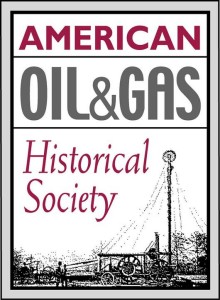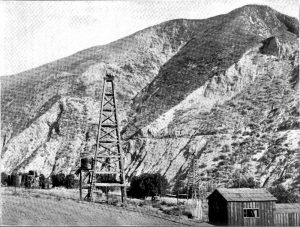Information here at Old Oil Stocks – in progress “V” will not find lost riches – see Not a Millionaire from Old Oil Stock. The American Oil & Gas Historical Society, which depends on donations, simply does not have resources to research of corporate histories.
However, AOGHS continues to look into forum queries as part of its energy education mission. Some investigations have revealed little-known stories like Buffalo Bill’s Shoshone Oil Company,
Many have found questionable dealings during booms and epidemics of “black gold” fever like Arctic Explorer turns Oil Promoter.
 Visit the Stock Certificate Q & A Forum and view company updates regularly added to the A-to-Z listing at Is my Old Oil Stock worth Anything? AOGHS will continue to look into forum queries, including these “in progress.”
Visit the Stock Certificate Q & A Forum and view company updates regularly added to the A-to-Z listing at Is my Old Oil Stock worth Anything? AOGHS will continue to look into forum queries, including these “in progress.”
Ventura Oil Development Company
The Clampitt brothers’ Ventura Oil Development Company in 1910 offered to sell blocks of 1,000 shares of stock at between 10 cents and 15 cents per share. The brothers published a variety of “quick sales” opportunities in newspapers and periodicals. An oil discovery a decade earlier had led to a flurry of drilling near Piru, California, had led to wild predictions of the largest oilfield in the state.
Records show Ventura Oil Development drilled at least one well in 1910 about a mile northeast of Piru, (a popular Hollywood filming location), but it appears to have been a dry hole.
By 1913 the company was reported by American Globe to be “in trouble or out of business.”A photo from November 1900 shows oil derricks at Piro Rancho – “both of them,” notes an historian at California’s Santa Clarita Valley TV Media Center.

Photograph from 1900 shows Piru, California, oil derricks – “both of them,” notes the Santa Clarita Valley TV Media Center when describing a magazine article promoting a nonexistent California oil boom. Photo courtesy SCVTV Media Center.
The photo illustrated a magazine story headlined, “Miles of Untold Wealth,” in The Land of Sunshine magazine, “which touts Piru’s supposed oil development potential.”
The turn-of-the-century magazine article proclaimed: “Two wells are now pumping, two more being drilled, and several more under way. In a short time six strings of tools will be working, and as fast as one well is completed another will be commenced. [I]t is reasonable to believe that the Piru rancho will soon be known as the largest oil field of the State.”
History would prove otherwise, concludes the Santa Clarita media center.
California’s first commercial oil well had been drilled in northern California in September 1876. Closer to Piru Rancho, the Los Angeles City oilfield was discovered on April 20, 1892, near present-day Dodger Stadium.
Vernon Winner Oil Company
A wildcat oil well blew in with great fanfare on March 20, 1920, about 15 miles south of Vernon, Texas. “It gushed for several days and thousands of people flocked to Vernon in a scramble to make investments,” noted the Wichita Daily Times.
The value of city properties soared thanks to the Sigler No. 1 well, which would prove to be a good but lonely oil producer. “Lumber yards and stores were opened up overnight,” the Wichita County newspaper reported. “Lease on lands miles from the well brought fabulous prices.”
Wichita County in North Texas had witnessed a surge in drilling since the 1918 discovery of the Burkburnett oilfield. Not long after the 1920 oil find near Vernon, county seat of neighboring Wilbarger County, the Vernon Winner Oil Company was one of many companies quickly formed to capitalize on the excitement. Within two months, the new company was pursuing investors with ads describing its $85,000 capital and 35 acres leased only three and a half miles from the Sigler No. 1 oil gusher. “Buy Stock in a Winner” was Vernon Winner Oil Company’s catchphrase.
In anticipation of oil wealth to rival that of Wichita County’s boom town Burkburnett and an earlier one at the Electra oilfield (1911), derricks sprang up as quickly as investment capital could be secured. But as drilling spread, speculators found only one dry hole after another. Vernon Winner Oil was one of the casualties.
“The boom collapsed. Oil men folded their maps and slipped away overnight,” the Wichita Times noted. “Investors in acreage and town property found themselves in possession of holdings that were worth but a fraction of their cost.”
Vista Petroleum
The California Department of Oil, Gas, and Geothermal Resources (DOGGR) includes a link to Oil & Gas Online Data with a “Well Search” option. Researchers can use this online record with operator names or API (American Petroleum Institute) numbers. Drilling records of Vista Petroleum can be found there, operator number 08818.
Vista Petroleum drilled 10 wells in California in the 1960s. Each API number links to documents that reveal permitting, drilling progress, dry holes and any production. Vista Petroleum’s trouble came from the Securities and Exchange Commission. A June 1971 SEC ruling noted:
During the period July 1969-April 1970, the firm (First General Corporation, Tulsa, Oklahoma) placed artificially created quotations for its own common stock and the common stocks of Viclad Industries and Vista Petroleum Corporation in the daily quotation sheets, disposed of such securities on behalf of favored customers who wished to liquidate their positions and recommended the purchase of the securities to other customers without disclosing material information concerning, among other things, the speculative and unseasoned nature of the securities and the facts that the firm had no meaningful information concerning the business operations and financial condition of Viclad and Vista and that the market price of registrant’s stock was not independently determined.
Volunteer Oil Company
In 1919 Volunteer Oil Company’s secretary, Ben W. Waid, a notorious promoter, was arrested and charged with misappropriating company funds. Convicted, he was sent to prison. The company did not succeed.
The stories of exploration and production companies joining petroleum booms (and avoiding busts) can be found updated in Is my Old Oil Stock worth Anything? The American Oil & Gas Historical Society preserves U.S. petroleum history. Please support this AOGHS.ORG energy education website. For membership information, contact bawells@aoghs.org. © 2020 AOGHS.

